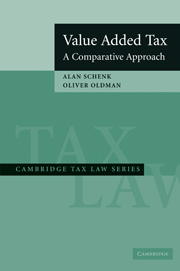Book contents
- Frontmatter
- Contents
- List of Tables, Figures, and Charts
- List of Cases
- Preface to the Revised Edition
- Value Added Tax
- 1 SURVEY OF TAXES ON CONSUMPTION AND INCOME, AND INTRODUCTION TO VALUE ADDED TAX
- 2 FORMS OF CONSUMPTION-BASED TAXES AND ALTERING THE TAX BASE
- 3 VARIETIES OF VAT IN USE
- 4 REGISTRATION, TAXPAYER, AND TAXABLE BUSINESS ACTIVITY
- 5 TAXABLE SUPPLIES OF GOODS AND SERVICES, AND TAX INVOICES
- 6 THE TAX CREDIT MECHANISM
- 7 INTRODUCTION TO CROSS-BORDER ASPECTS OF VAT
- 8 TIMING, TRANSITION AND VALUATION RULES
- 9 ZERO RATING AND EXEMPTIONS AND GOVERNMENT ENTITIES AND NONPROFIT ORGANIZATIONS
- 10 GAMBLING AND FINANCIAL SERVICES (OTHER THAN INSURANCE)
- 11 INSURANCE
- 12 INTERJURISDICTIONAL ASPECTS OF VAT IN FEDERAL COUNTRIES AND COMMON MARKETS
- 13 REAL PROPERTY
- 14 PROPOSALS FOR U.S. TAX ON CONSUMPTION
- APPENDIXES
- Index
2 - FORMS OF CONSUMPTION-BASED TAXES AND ALTERING THE TAX BASE
Published online by Cambridge University Press: 06 January 2010
- Frontmatter
- Contents
- List of Tables, Figures, and Charts
- List of Cases
- Preface to the Revised Edition
- Value Added Tax
- 1 SURVEY OF TAXES ON CONSUMPTION AND INCOME, AND INTRODUCTION TO VALUE ADDED TAX
- 2 FORMS OF CONSUMPTION-BASED TAXES AND ALTERING THE TAX BASE
- 3 VARIETIES OF VAT IN USE
- 4 REGISTRATION, TAXPAYER, AND TAXABLE BUSINESS ACTIVITY
- 5 TAXABLE SUPPLIES OF GOODS AND SERVICES, AND TAX INVOICES
- 6 THE TAX CREDIT MECHANISM
- 7 INTRODUCTION TO CROSS-BORDER ASPECTS OF VAT
- 8 TIMING, TRANSITION AND VALUATION RULES
- 9 ZERO RATING AND EXEMPTIONS AND GOVERNMENT ENTITIES AND NONPROFIT ORGANIZATIONS
- 10 GAMBLING AND FINANCIAL SERVICES (OTHER THAN INSURANCE)
- 11 INSURANCE
- 12 INTERJURISDICTIONAL ASPECTS OF VAT IN FEDERAL COUNTRIES AND COMMON MARKETS
- 13 REAL PROPERTY
- 14 PROPOSALS FOR U.S. TAX ON CONSUMPTION
- APPENDIXES
- Index
Summary
FORMS OF CONSUMPTION-BASED TAXES
INTRODUCTION
In this section of the chapter, there is a discussion of a direct tax on individuals that is measured by their level of consumption rather than their income. This tax is commonly referred to as a cash-flow or consumption-based income tax. Most taxes on consumption are indirect taxes. These taxes, also discussed in this chapter, are collected by sellers of taxable goods and services and are expected to be borne by final consumers of those goods and services. The indirect tax on consumption may take the form of a single-stage tax like the retail sales tax or a multistage tax like a value added tax.
A value added tax is a generic name associated with a multistage tax that is levied on the value added by each business firm at every stage of production and distribution of goods and services. In part, the description of a VAT depends on the method used in calculating tax liability. In this chapter, there is a discussion of the addition, sales-subtraction, and credit-subtraction methods of calculating VAT liability.
The legislature may alter a VAT base by removing some sellers or some goods and services. This alteration of tax base is accomplished by providing an exemption for designated businesses (such as small businesses) or entities, such as units of government or nonprofit organizations. The legislature also can alter the tax base by granting exemption or altering the rate for particular goods and services, regardless of the nature of the seller.
- Type
- Chapter
- Information
- Value Added TaxA Comparative Approach, pp. 30 - 57Publisher: Cambridge University PressPrint publication year: 2007



